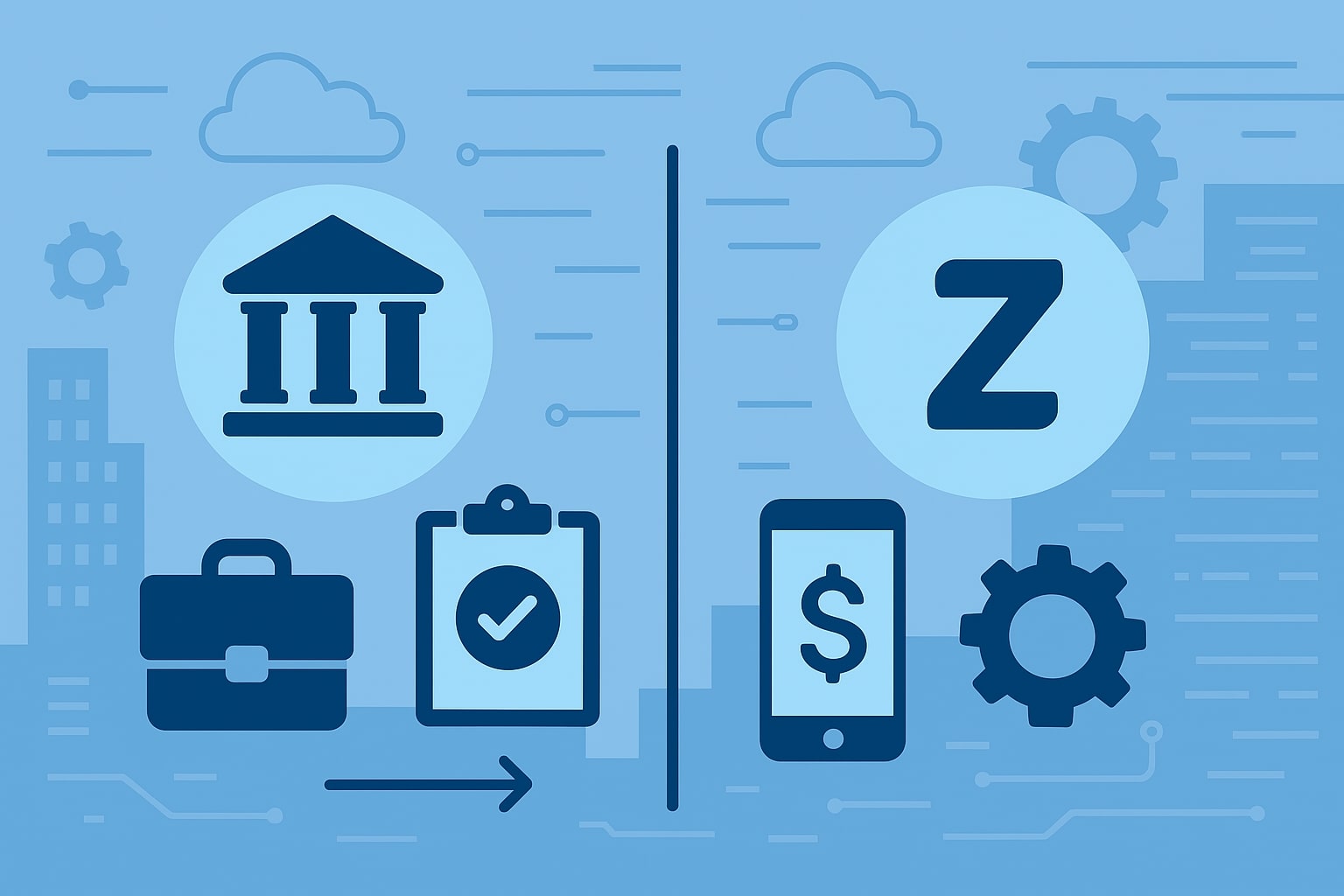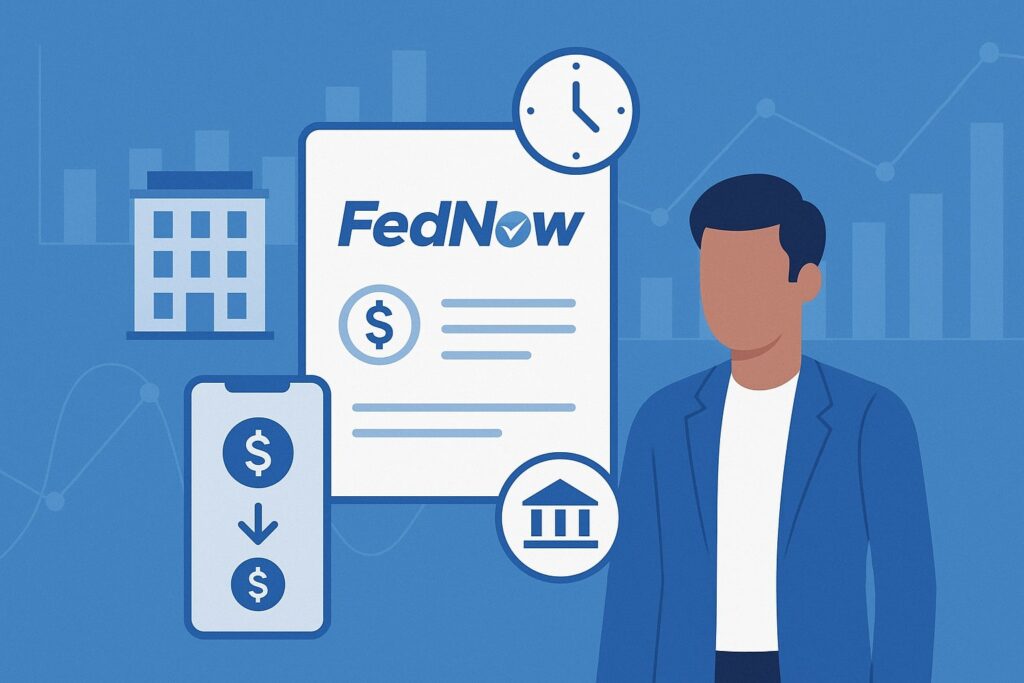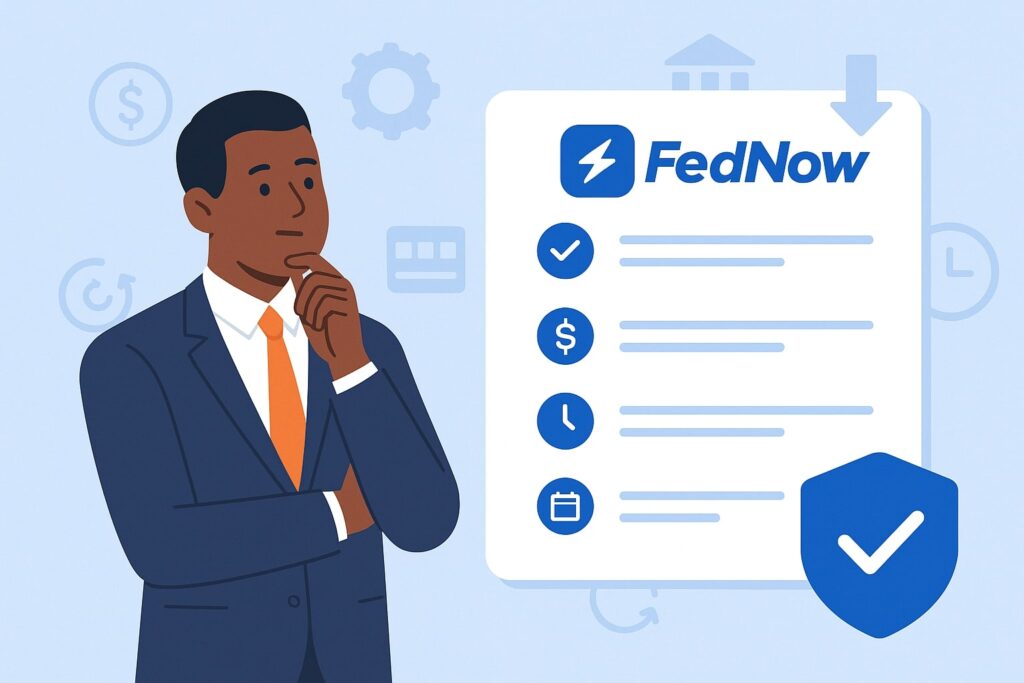
By p2pbusinesspayments October 26, 2025
Choosing the right way to move money is a real business decision now—not just a back-office chore. Two names you’ll hear a lot are FedNow and Zelle. Both move funds quickly between U.S. bank accounts, but they were built for different jobs.
In this guide, you’ll get a clear, up-to-date comparison of FedNow vs Zelle for business payments, with practical use cases, risks, costs, and decision checklists. Where important, we cite primary sources so you can verify the details and share them with your team.
FedNow and Zelle each have strengths; the best choice depends on whether you need an instant payment rail with 24/7 settlement (FedNow) or a P2P-style request-and-pay experience that lives in banking apps your customers already use (Zelle).
What FedNow Is (and Isn’t) for the U.S. Businesses

FedNow is the Federal Reserve’s instant payments service. It’s a real-time payment rail—infrastructure banks and credit unions use to send and receive credit push transfers 24/7/365.
Unlike ACH (batch) or wires (typically business hours), FedNow runs continuously with immediate interbank settlement, making cleared funds available to the receiver within seconds. For a business, that means you can pay a supplier at 10:43 p.m. on a Sunday and they can see good funds right away—no “processing tomorrow” banner.
The Fed designed FedNow with continuous business days, robust security controls, and operating rules under Reg J/Operating Circular 8 to support payment integrity.
In 2025, the Fed introduced account activity thresholds (value/velocity controls) that participating financial institutions can set by customer segment for risk mitigation.
At the same time, the maximum per-payment limit increased from $500,000 to $1,000,000 (banks can still set their own, lower customer limits; the Fed’s default remains lower). These updates make FedNow more practical for higher-value B2B payments like supplier invoices, real-estate disbursements, and payroll funding.
Operationally, FedNow is bank-to-bank only—you don’t “sign up” for FedNow directly as a business. Your bank or credit union connects to FedNow and offers instant payments to you via APIs, online banking, or treasury portals.
Banks also manage liquidity and Liquidity Management Transfers (LMTs), which have specific operating windows on weekdays and run 24/7 on weekends and Fed holidays. For your team, the key takeaway is that FedNow enables always-on money movement with immediate finality when your institution turns it on for your accounts.
What Zelle Is (and Isn’t) for the U.S. Businesses

Zelle is a bank-owned network (Early Warning Services) known for its clean, consumer-friendly experience inside thousands of U.S. banking apps. Zelle started as P2P, then expanded to Zelle for Business, letting small businesses receive payments using a business email, U.S. mobile number, or Zelle tag.
Customers who already have Zelle in their bank app can pay you quickly—often in seconds—with no separate wallet to fund. For many micro-merchants and service pros, that familiarity is the appeal.
Fees and limits with Zelle are set by each bank, not by Zelle itself. Many banks don’t charge a fee to receive Zelle payments, but they commonly enforce per-transaction, daily, or monthly caps—especially on business profiles.
These caps vary widely by institution and can limit Zelle’s usefulness for large B2B remittances or payroll. In other words, Zelle is convenient but not designed as a high-value B2B rail.
Under the hood, Zelle is a network and experience layer, not a public rail. The actual settlement between banks can ride multiple rails; since 2021, Zelle payments can clear and settle over the RTP network (The Clearing House) when participating institutions choose to do so.
That operational detail matters: Zelle is “instant” to the user, but the settlement mechanics depend on how the banks exchange funds. For your risk and treasury team, that means funds availability is immediate to customers, while interbank settlement may follow a different timeline depending on the rails chosen by the banks.
FedNow vs Zelle: Core Differences That Matter to Businesses
At a glance, both FedNow and Zelle feel “instant.” But they solve different business problems.
- Rail vs Networked Experience: FedNow is a national instant rail run by the Fed—banks plug in and offer real-time credit transfers.
Zelle is a networked user experience integrated into banking apps, excellent for collecting money from consumers or very small businesses who already use Zelle. FedNow is rail-centric; Zelle is app-centric. - Settlement Finality & 24/7 Operations: FedNow provides real-time interbank settlement 24/7/365 with continuously rolling business days. That makes it strong for time-critical disbursements and treasury moves.
Zelle provides instant consumer-visible availability, and when banks choose RTP, those Zelle payments can settle instantly on that private rail; otherwise, settlement timing can vary by bank arrangements. - Transaction Limits & Value: FedNow’s maximum limit increased to $1,000,000 in 2025 (banks choose their customer caps; many keep them lower).
Zelle’s business limits are bank-specific and typically designed for consumer and small-ticket flows. If you need high-value B2B payments, FedNow’s ceiling and rule set are a better fit. - Fees & Pricing: FedNow pricing to banks is published by the Fed; banks then price the service to you. Zelle generally does not charge users directly, but your bank may.
In practice, many banks offer Zelle at no fee to small businesses, but limits—not price—tend to be the constraint. (Always confirm with your bank’s treasury schedule.) - Use Cases: FedNow shines for time-sensitive B2B, payroll on holidays, after-hours supplier payments, emergency payouts, marketplace settlements, and cash management.
Zelle shines for getting paid by consumers (home services, tutoring, local retail) and low-to-mid-value B2B where both sides banking with Zelle-enabled institutions prefer a familiar app flow.
When Businesses Should Prefer FedNow (and Why)

If your pain point is timing, not app adoption, FedNow is compelling. Funds move within seconds and settle across banks immediately, even at midnight or on a federal holiday. That reliability helps your AP team avoid cutoff times and weekend delays.
It also improves supplier relationships—you can release payment exactly when a condition is met, and your vendor can see good funds instantly.
The Fed’s 2025 risk features (account activity thresholds) also make enterprise rollouts more comfortable by allowing banks to set value/velocity controls by segment—useful when you’re enabling instant pay for newer customers or sub-merchants.
From a treasury angle, FedNow reduces float ambiguity. Continuous business days mean you can orchestrate just-in-time liquidity, especially when paired with your bank’s Liquidity Management Transfers.
For high-value scenarios, the new $1M max (subject to bank settings) broadens FedNow’s scope: think manufacturing, wholesale distribution, commercial real estate, and same-day supplier releases without wire fees or cutoff anxiety.
If you need API-first integration, many banks expose FedNow initiation and status endpoints through their commercial portals or embedded banking partners, making FedNow a building block for real-time experiences in your own platform.
When Businesses Should Prefer Zelle (and Why)
Zelle is strongest where the user experience is the primary driver. If your customers already have Zelle in their bank app, they can pay your business using an email, mobile number, or Zelle tag—no sign-ups or wallet top-ups.
That makes Zelle a good fit for local services, appointments, prosumer/sole-prop operations, and any scenario where you’d otherwise take checks or wait for ACH.
Funds typically appear in your account quickly; for the payer, it’s just “tap Zelle” and done. Many banks offer no additional fee for receiving Zelle as a business, though they’ll enforce their own transaction caps and daily limits.
From an operations standpoint, Zelle cuts friction and reduces check handling. If your biggest hassle is chasing small invoices and you don’t want to stand up a full card acceptance stack, Zelle can be a high-adoption bridge: familiar to consumers, bank-grade authentication, and fast posting to your deposit account.
If both counterparties bank with institutions that clear Zelle over RTP, those transfers can have instant settlement at the interbank layer—again, that’s up to the banks’ configuration, not something you control directly in your back office.
Speed, Settlement, and Risk: What Your Finance Team Should Know
Both FedNow and Zelle feel instant to the end user, but instant availability and final settlement are not identical. FedNow provides immediate interbank settlement and continuous business days, which simplifies reconciliation and risk treatment—good funds arrive and are final.
Zelle guarantees fast availability in the customer experience; interbank settlement can ride RTP (instant) or other arrangements, depending on the participating banks.
For finance, this means chargeback-style reversals don’t exist the way they do on cards; both FedNow and RTP payments are credit-push and irrevocable once sent (except via dispute procedures under network rules). This irrevocability is why fraud controls and verification steps matter.
In 2025, the Fed introduced account activity thresholds on FedNow so banks can tune value and velocity by customer segment (e.g., new SMB vs established enterprise) and reduce fraud exposure without bluntly lowering limits for everyone.
Zelle participants use risk analytics, name/ID verification, and education prompts to reduce misdirected or fraud-induced payments. Your internal policies should mirror card-not-present hygiene: verify payee details, maintain allowlists, and use dual controls for higher-value releases.
Limits, Pricing, and Operating Windows (Explained Plainly)
- FedNow limits: As of 2025, the network maximum is $1,000,000 per transfer; your bank can set lower customer limits, and many will—especially during rollout.
The Fed also offers Liquidity Management Transfers with defined weekday windows and 24/7 weekend/holiday availability, while funds transfers operate continuously. Expect your bank to publish its per-payment and daily caps, cutovers, and API throttles in your treasury agreement. - Zelle limits & fees: Zelle itself doesn’t charge businesses directly; your bank sets the fees (if any) and limits. In practice, most banks don’t charge to receive Zelle payments, but business profile limits might cap transaction size or daily throughput, which can be a real ceiling for B2B use.
If you plan to rely on Zelle for receivables, confirm your bank’s per-transaction and daily limits plus any per-month caps before pushing customers to that flow. - Operating hours: FedNow and Zelle-enabled experiences run around the clock. FedNow’s settlement is 24/7/365 by design; Zelle’s user experience is always on, while settlement mechanics depend on bank configurations (and can use RTP for instant interbank settlement). For night-and-weekend payouts, that’s the core advantage over ACH and wire cutoffs.
Compliance, Rules, and Disputes
FedNow operations are governed by Reg J (subpart C) and Operating Circular 8, with detailed rules on message formats, returns, and exception handling.
Because most FedNow payments are irrevocable, fraud and error handling rely on interbank cooperation (request for return) and institution policies, not chargebacks. Your AP and AR teams should maintain confirmation steps, use dual approval for larger amounts, and log recipient verification for auditability.
Zelle operates under Early Warning Services rules and each bank’s online banking agreement. Consumer protection expectations differ from business use; Zelle for Business typically treats you as a commercial user with fewer error-resolution protections than a consumer.
Practical takeaway: train staff to confirm recipient identifiers (email/phone/tag), add allowlists, and keep a Zelle-specific SOP with dollar thresholds for secondary review. If a payment is misdirected, contact your bank immediately—speed is essential for any attempted recovery.
Implementation Tips: Rolling Out FedNow or Zelle in Your Payment Mix
For FedNow:
- Ask your bank about FedNow availability for your business accounts and customer-level limits. Confirm whether you’ll have API access or only portal initiation.
- Define risk controls: who can send, dual approvals, and internal value/velocity tiers that mirror your bank’s thresholds.
- Map use cases to dollar bands (e.g., under $25k autopay, $25k–$250k dual approval, $250k–$1M CFO approval).
- Update supplier onboarding to collect routing identifiers for FedNow and establish payment reason codes for reconciliation.
- Pilot with a small vendor set, then expand as your ops team gets comfortable.
For Zelle:
- Confirm your bank offers Zelle for Business, request your limits and fee schedule, and enable the business profile.
- Publish your Zelle tag/identifier on invoices and confirmations with clear instructions for customers.
- Add name matching prompts (“Send to Acme Services LLC at 555-555-5555”) and a contact method if a payer doesn’t see your profile.
- Set per-payment internal limits and dual controls for outbound Zelle.
- Periodically review failed/returned payments and reach out to frequent customers about recurring billing alternatives (ACH, cards) if they’re hitting caps.
FedNow vs Zelle vs “Everything Else” (Context You’ll Be Asked About)
Your executive team will ask why not just use RTP (The Clearing House) or ACH same-day. Short answer: RTP is another instant rail like FedNow with wide bank coverage, and Zelle can use RTP for interbank settlement.
ACH Same Day is faster than legacy ACH but still batch with cutoffs and no 24/7 settlement. As instant payments mature, checks are rapidly disappearing from U.S. commerce, and instant rails are forecast to grow sharply through the decade. Expect your customers and suppliers to assume instant options exist—plan accordingly.
Decision Framework: Picking the Right Tool for Each Flow
Ask these five questions:
- Who’s paying whom? Consumer→Business or Business↔Business? Zelle shines for C→B; FedNow fits B↔B.
- What’s the ticket size? Under a few thousand dollars? Zelle may be fine. Five-figure invoices? FedNow (or wires) are safer fits given limits and documentation.
- How time-critical is settlement? If immediate, 24/7 finality matters—favor FedNow (or RTP).
- Who controls the experience? If you need branded, embedded flows with APIs and precise reconciliation, talk FedNow with your bank.
- What’s your fraud posture? If irrevocability worries you, start with smaller caps, dual controls, and allowlists regardless of rail/network.
FAQs
Q.1: Is FedNow available at every bank yet?
Answer: No. Participation continues to expand, but you must confirm with your bank or credit union whether they support sending and receiving for your business accounts. The Fed maintains resources and stats for participating institutions and volumes, and availability is growing.
Q.2: What is the current FedNow transaction limit?
Answer: In 2025 the Fed raised the network max to $1,000,000 per transfer. Your bank’s customer limit may be lower and can differ by segment. Always ask your bank’s treasury team for your exact caps.
Q.3: Does Zelle charge businesses a fee?
Answer: Zelle itself generally doesn’t charge; your bank sets fees and limits. Many banks don’t charge to receive Zelle payments but enforce transaction caps. Verify your specific pricing and limits with your institution.
Q.4: Is Zelle truly “instant” like FedNow?
Answer: To users, Zelle typically shows funds instantly. At the interbank level, banks can settle Zelle over RTP (instant) or other arrangements. FedNow provides real-time interbank settlement natively. That’s why FedNow is often preferred for high-value B2B.
Q.5: Can I use both FedNow and Zelle?
Answer: Yes—and many businesses should. Use Zelle to collect small payments where the experience drives adoption, and use FedNow to pay suppliers, contractors, and partners when timing and final settlement matter. Your bank can advise on enablement for each.
Q.6: How do fraud and errors get handled?
Answer: Both are credit-push and generally irrevocable once sent. FedNow uses Reg J/OC-8 rules; banks can request returns in limited cases. Zelle relies on network and bank policies. Your best defense is process: verify recipients, use dual approvals, and maintain allowlists for larger amounts.
Q.7: What about ACH and cards—do these go away?
Answer: No. ACH remains cheap and ubiquitous for non-urgent payments; cards remain essential at POS and online. Instant rails like FedNow are an addition, not a replacement, used when timing and finality are the priority. Industry trends, however, point to rapid growth in instant payments as checks fade.
Conclusion
If you run U.S. business payments, think portfolio, not silver bullet. FedNow gives you an always-on, real-time rail with immediate interbank settlement, higher value ceilings (now up to $1M at the network level), and risk tooling that banks can tailor by customer segment.
It’s ideal for B2B disbursements, time-critical releases, payroll funding, and embedded real-time experiences in your platform. Zelle gives you a familiar, low-friction way to collect from consumers and very small businesses, often with no additional bank fees but with bank-defined limits that cap larger flows.
In practice, many firms use both: Zelle to accelerate small receivables and FedNow to modernize high-value payables and treasury moves.
As instant payments keep expanding in the U.S., the winning strategy is to route by use case: pick the rail or network that matches the amount, urgency, user experience, and risk profile—then automate controls so every dollar takes the smartest path.